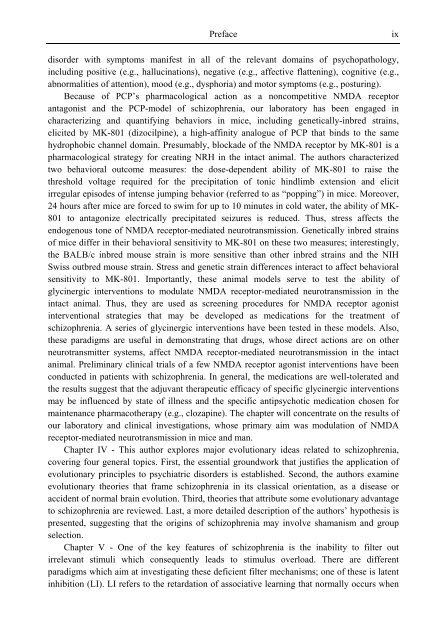Schizophrenia Research Trends
Schizophrenia Research Trends
Schizophrenia Research Trends
- No tags were found...
Create successful ePaper yourself
Turn your PDF publications into a flip-book with our unique Google optimized e-Paper software.
Prefaceixdisorder with symptoms manifest in all of the relevant domains of psychopathology,including positive (e.g., hallucinations), negative (e.g., affective flattening), cognitive (e.g.,abnormalities of attention), mood (e.g., dysphoria) and motor symptoms (e.g., posturing).Because of PCP’s pharmacological action as a noncompetitive NMDA receptorantagonist and the PCP-model of schizophrenia, our laboratory has been engaged incharacterizing and quantifying behaviors in mice, including genetically-inbred strains,elicited by MK-801 (dizocilpine), a high-affinity analogue of PCP that binds to the samehydrophobic channel domain. Presumably, blockade of the NMDA receptor by MK-801 is apharmacological strategy for creating NRH in the intact animal. The authors characterizedtwo behavioral outcome measures: the dose-dependent ability of MK-801 to raise thethreshold voltage required for the precipitation of tonic hindlimb extension and elicitirregular episodes of intense jumping behavior (referred to as “popping”) in mice. Moreover,24 hours after mice are forced to swim for up to 10 minutes in cold water, the ability of MK-801 to antagonize electrically precipitated seizures is reduced. Thus, stress affects theendogenous tone of NMDA receptor-mediated neurotransmission. Genetically inbred strainsof mice differ in their behavioral sensitivity to MK-801 on these two measures; interestingly,the BALB/c inbred mouse strain is more sensitive than other inbred strains and the NIHSwiss outbred mouse strain. Stress and genetic strain differences interact to affect behavioralsensitivity to MK-801. Importantly, these animal models serve to test the ability ofglycinergic interventions to modulate NMDA receptor-mediated neurotransmission in theintact animal. Thus, they are used as screening procedures for NMDA receptor agonistinterventional strategies that may be developed as medications for the treatment ofschizophrenia. A series of glycinergic interventions have been tested in these models. Also,these paradigms are useful in demonstrating that drugs, whose direct actions are on otherneurotransmitter systems, affect NMDA receptor-mediated neurotransmission in the intactanimal. Preliminary clinical trials of a few NMDA receptor agonist interventions have beenconducted in patients with schizophrenia. In general, the medications are well-tolerated andthe results suggest that the adjuvant therapeutic efficacy of specific glycinergic interventionsmay be influenced by state of illness and the specific antipsychotic medication chosen formaintenance pharmacotherapy (e.g., clozapine). The chapter will concentrate on the results ofour laboratory and clinical investigations, whose primary aim was modulation of NMDAreceptor-mediated neurotransmission in mice and man.Chapter IV - This author explores major evolutionary ideas related to schizophrenia,covering four general topics. First, the essential groundwork that justifies the application ofevolutionary principles to psychiatric disorders is established. Second, the authors examineevolutionary theories that frame schizophrenia in its classical orientation, as a disease oraccident of normal brain evolution. Third, theories that attribute some evolutionary advantageto schizophrenia are reviewed. Last, a more detailed description of the authors’ hypothesis ispresented, suggesting that the origins of schizophrenia may involve shamanism and groupselection.Chapter V - One of the key features of schizophrenia is the inability to filter outirrelevant stimuli which consequently leads to stimulus overload. There are differentparadigms which aim at investigating these deficient filter mechanisms; one of these is latentinhibition (LI). LI refers to the retardation of associative learning that normally occurs when
















